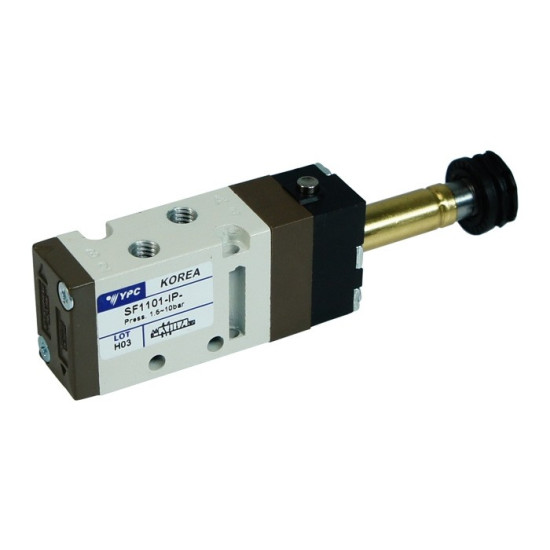SF Solenoid Valves - Universal Pneumatic Control Solutions
SF Solenoid Valves - The Universal Solution in Pneumatics
The SF solenoid valves from Yonwoo Pneumatic.co., Ltd. (YPC) represent the most versatile and popular line in our range of valves and control coils. Designed to deliver exceptional performance in virtually any industrial application, these universal solenoid valves have established themselves as our best-selling product thanks to their reliability, versatility, and excellent value for money.
Technical Specifications
- Body material: Corrosion-resistant anodized aluminum
- Available configurations: 5/2 and 5/3 ways
- Pressure range: 2-8 bar (29-116 psi)
- Temperature range: 23°F to 140°F (-5°C to +60°C)
- Actuation options: Electric (via coils) and pneumatic
- Available voltages: 12V DC, 24V DC, 24V AC, 110V AC, 230V AC
- Design: Modular for easy integration
- Compatibility: With plates for SF valves and SF valve islands
Key Advantages
Their modular design allows for easy integration into existing systems, while standard connections facilitate installation and routine maintenance. A notable feature is their ability to operate efficiently across a wide range of pressures and temperatures, making them ideal for various industrial applications. Their low power consumption contributes to the energy efficiency of facilities where they are implemented.
Typical Applications
- Industrial automation systems
- Production and assembly lines
- Packaging and wrapping machinery
- Material handling equipment
- Pneumatic control systems in heavy industry
- Applications requiring frequent operation cycles
Their high-quality design ensures precise switching and long service life, minimizing downtime and maintenance costs. Their popularity among industry professionals is backed by consistent and reliable performance in critical applications across the United States, from automotive manufacturing in Michigan to food processing in California.
At Pneumatig.eu, we offer the complete range of SF solenoid valves, with fast shipping options nationwide and specialized technical support to help you select the ideal valve for your specific application. Our valves comply with all relevant ANSI/NFPA standards for pneumatic systems in industrial environments.
What makes SF solenoid valves suitable for US industrial applications?
SF solenoid valves are ideal for US industrial applications due to their compatibility with standard US pneumatic systems (operating at 29-116 psi), wide voltage options including 110V AC (common in US facilities), and compliance with ANSI/NFPA pneumatic standards. Their robust design handles the demanding conditions found in American manufacturing environments, from automotive plants to food processing facilities.
How do SF solenoid valves contribute to energy efficiency?
SF solenoid valves contribute to energy efficiency through their low power consumption design, which reduces electricity usage in continuous operations. This aligns with US energy efficiency initiatives and can help facilities meet sustainability goals. Additionally, their precise switching minimizes air leakage and ensures compressed air is used efficiently, addressing a major source of energy waste in pneumatic systems common in US manufacturing.
What maintenance requirements do SF solenoid valves have?
SF solenoid valves require minimal maintenance compared to other pneumatic components. Routine maintenance typically involves periodic inspection for air leaks, checking electrical connections, and ensuring the compressed air supply is properly filtered to prevent contamination. In US industrial environments, it's recommended to include these valves in scheduled maintenance programs, typically quarterly or semi-annually depending on the application intensity and environmental conditions.


Login and Registration Form